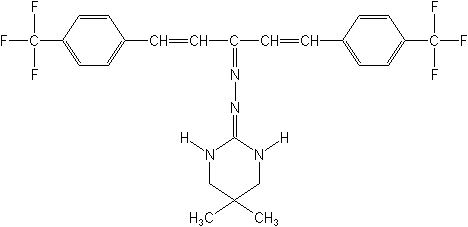-
Common NameHydramethylnon
-
中文通用名氟蚁腙
-
IUPAC5,5-dimethylperhydropyrimidin-2-one 4-trifluoromethyl-α-(4-trifluoromethylstyryl)cinnamylidenehydrazone
-
CAStetrahydro-5,5-dimethyl-2(1H)-pyrimidinone [3-[4-(trifluoromethyl)phenyl]-1-[2-[4-(trifluoromethyl)phenyl]ethenyl]-2-propenylidene]hydrazone
-
CAS No.67485-29-4
-
Molecular FormulaC25H24F6N4
-
Molecular Structure
-
Physical PropertiesMolecular weight:494.5g/mol; Physical form:Yellow to tan crystals. Density:0.299 (25℃); Composition:Tech. grade is >95% pure. Melting point:189-191 ℃; Vapour pressure:<0.0027 mPa (25℃); a value of <0.0008 mPa (45℃) has also been reported; Henry constant:7.81 × 10-1 Pa m3 mol-1 (25℃, calc.); Partition coefficient(n-octanol and water):logP = 2.31; Solubility:In water 0.005-0.007 mg/l (25℃). In acetone 360, ethanol 72, 1,2-dichloroethane 170, methanol 230, isopropanol 12, xylene 94, chlorobenzene 390 (all in g/l, 20℃).; Stability:When stored in original unopened container, stable in excess of 24 mo at 25℃, 12 mo at 37℃, and 3 mo at 45℃. Undergoes photolysis in sunlight ( DT50 c. 1 h).
-
ToxicologyOral:Acute oral LD50 for male rats 1131, female rats 1300 mg/ kg. Percutaneous:Acute percutaneous LD50 for rabbits >5000 mg/kg. Not a skin irritant to rabbits or guinea pigs; reversible irritant to eyes of rabbits. No skin sensitisation (guinea pigs). Inhalation: LC50 (4 h) for rats >5 mg/l air (aerosol or dust). Phytotoxicity:No phytotoxicity observed.
-
Environmental ProfileEcotoxicology:Bees:Dust is non-toxic topically to honeybees at 0.03 mg/bee.Birds:Acute oral LD50 for mallard ducks >2510, bobwhite quail 1828 mg/ kg.Daphnia: LC50 (48 h) 1.14 mg/l; little hazard would be expected under field conditions because of the very low solubility in water.Fish:Toxic under laboratory conditions using a solvent, but very little risk to fish is expected under normal field conditions because of the compound's low solubility in water and rapid degradation in sunshine.LC50 (96 h) for bluegill sunfish 1.70, rainbow trout 0.16, channel catfish 0.10 mg/l; for carp 0.67, 0.39, and 0.34 mg/l (24, 48, and 72 h, respectively).Daphnia LC50 (48 h) 1.14 mg/l; little hazard would be expected under field conditions because of the very low solubility in water.Bees Dust is non-toxic topically to honeybees at 0.03 mg/bee.
Environmental fate:Animals:In rats, following oral administration, rapidly eliminated in the faeces and urine. No residues were detectable in the milk or tissues of goats (0.2 mg/ kg in the daily diet for 8 days). No residues were found in the milk Soil:Rapidly degraded in sunlight by photolysis ( DT50 <1 h). Half-life in sandy loam is c. 7 d; half-life when incorporated in sandy loam is c. 28 d. Formulated bait decomposes rapidly in daylight. Not mobile and doPlant:Residues in grass 4 months after treatment were <0.01 ppm. Negligible residues were found in radishes, barley, and french beans planted 3 months after treatment of the soil. -
Transport InformationHazard Class:III(Slightly hazardous)
Porduct NewsMore
Orthosulfamuron boosts sugarcane production, study finds
Glyphosate price plummets 40% in one year in Argentina
Indian govt stops imports of herbicide Glufosinate priced below Rs 1,289 per kg
Carbendazim fungicide wins victory in Brazilian Parliament
Corteva presents new pre-emergent herbicide Linear for sugarcane in Brazil
Picloram Triclopyr Aminopyralid
Revolutionizing disease prevention: BASF launches new rice fungicide Cevya® in China
Thiamethoxam is allowed again in Brazil by a judicial decision
Bayer develops alternative to glyphosate herbicide

 0
0 Subscribe
Subscribe
